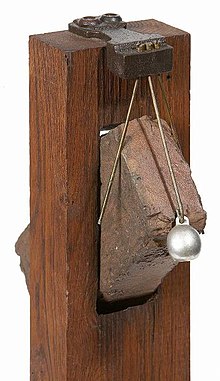Michael Steiner (artist)
Michael Steiner (* 1955 in Rietberg ) is a German visual artist and developer of the magnetic painting method.
Life
In 1977, Steiner studied production and manufacturing technology. In 1978 he began his first exercises in fine arts. In 1988 he invented a surface design process using magnets.
In 1989 he learned life drawing from Woldemar Winkler . In 1989 she participated in the international SYRLIN art award. In 1990 he learned free artistic design with Jochen Jäger. In 1994 the Magnetic Painting patent was granted.
In the same year he took part in the PRIX ARS ELECTRONICA in Linz. In 1997 he took part in the 17th Art Prize of the Kreissparkasse Esslingen-Nürtingen. Also in 1997 an essay about Steiner was published in PM Neue Kunsttechnik - Painting with Magnets .
Also in 1997 he had an exhibition as part of the Südwest-LB-Druckgrafik-Kunstpreis in Stuttgart. In 2003 an exhibition followed in the Kunstraum Soltau. In 2007 he had a solo exhibition under the title 8 Kraftschafften and other color battles in the Raum für Kunst Paderborn. In the same year Steiner took part in an exhibition at MARTa Herford as part of the recycling art award. He also exhibited design objects in the MARTa as part of the 2008 Recycling Design Prize. In 2009, his installation "Geo Metrie 2008ff", which addresses the Financial Market Stabilization Act (FMStG), was on view at Kiosk24 in Herford.
plant
Steiner uses magnetic forces and self-developed machines to shape paint on canvas. He also makes sculptures, installations and design objects from various materials. By using serial techniques and at the same time exposing the production process to the randomness between magnetic forces and color, the precision of the machine is undermined and becomes a paradox.
At first he used traditional methods of artistic design to highlight tensions between surface and space. The experience of space through the construction of it then led him to the method of iterative design. The resulting works have an effect through their formed colors and the striving from the surface into the third dimension.
Web links
- Michael Steiner Homepage
- The video Energy Art on Youtube; illustrates the production process
- Michael Steiner on the culture server NRW
- European patent 0347783 Method and device for generating patterns by means of color or the like. on documents
| personal data | |
|---|---|
| SURNAME | Steiner, Michael |
| BRIEF DESCRIPTION | German visual artist |
| DATE OF BIRTH | 1955 |
| PLACE OF BIRTH | Rietberg |


